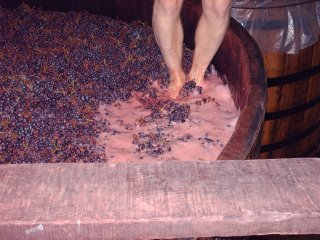Many years ago I went through a phase of being really into art - impressionist (mostly monet), pop-art (lichtenstein and warhol) and of course the surrealist movement spearheaded by Dali. I kind of got into Dali by way of rave flyers, promotional leaflets for all night dance events, for which Dali was ideal material. Works like the persistance of memory and the great masturbator were frequently used for flyers due to their striking imagery and allusions to the underlying drug culture of the day. So when I was recently shown a wine labelled in homage to Dali I was quite interested.
Bodegas Altanza was one of the wineries visited on my recent visit to Rioja with Wines of Spain. It was the last of the wineries we were visiting and we werent sure what to expect really. We had seen the full spectrum of styles from the old school style of Remelluri, to the ultra-modern Baigorri and somewhere in the middle of those two extremes sat Altanza. The winery itself was pretty state of the art, lots of polished steel, temperature controlled tanks, a huge, clean barrel hall with loads of french oak barrels (including a few from Demptos!), with the odd transylvanian, russian and american oak barrels kicking around too, a throwback from when they experimented with different oaks to see what impact it would have on the wines. But when you taste their wines, there is a sense of tradition about them, they seem to sit in the middle of the two "camps" - fresh and fruity characters but structured and complex, with well integrated oak flavours and a touch of the raw meaty essense that I tend to find in old school rioja.
Twice now, Altanza has produced a wine of such complexity, intensity and sheer character, that they have felt it deserved a special treatment. So they decided to honour the great spanish artists, the first to be honoured was Miro, in 2001 followed three years later by Dali. The Miro was bottled in a dense, incredably heavy burgundy bottle, Dali is in a monsterously heavy bordeaux bottle. It is sold in packs of three, each bottle adorned with a label depicting one of Dali's lesser known works (the sheer cost of licensing the images from the Dali estate precludes using the more famous images, besides which the estate controls which images they are allowed to choose from). It would be fair to say that having tasted the wine, if it was given to me blind and I was asked to pair it with an artist, then I dont doubt that Dali would be my first choice. It is an intense experience, rich concentrated flavours seem to jumble across your palate - dark red soft fruits mixed with a touch of spice, vanilla and other oaky influenced flavours all with a definate savoury edge to them. The wine stays with you, working away at your brain, continually assaulting your tastebuds with flavour long after you have put the glass down. Its intense, much in the same was as standing underneath Dali's Christ of St John on the Cross, currently residing at the Kelvingrove museum in Glasgow. Even as an athiest, the immenseness of the canvas (roughly a metre wide by two metres tall) and the perspective of the painting all seem to prey on you long after you have moved on to the next piece. It is easy to see why Dali was chosen for this wine.
Subscribe to:
Post Comments (Atom)


1 comment:
What an amazing reference to Dali! Fascinating story. I'm familiar with this wine and the description is accurate.
Post a Comment